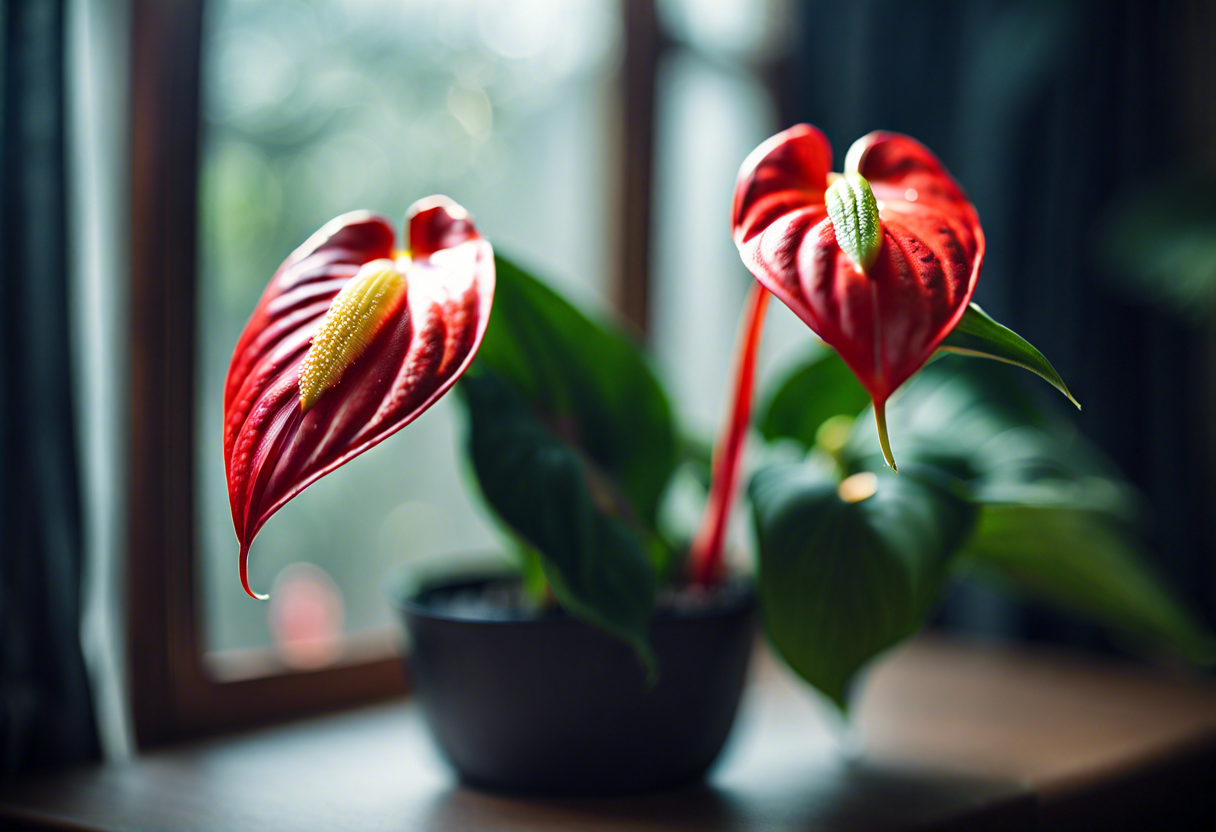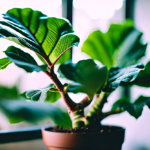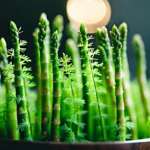The Ideal Growing Conditions for Anthurium Plants
Anthurium plants, also known as flamingo flowers or painter’s palette, are tropical plants that are beloved for their vibrant and long-lasting blooms. To ensure the health and vitality of these stunning plants, it is essential to provide them with the ideal growing conditions. Here’s a comprehensive care guide for Anthurium plants.
1. Light: Anthurium plants thrive in bright, indirect light. Place them near a window with filtered sunlight, or provide them with artificial light sources such as fluorescent or LED grow lights. Avoid exposing the plants to direct sunlight, as it can cause their leaves to scorch.
2. Temperature: Anthuriums prefer temperatures between 65°F and 80°F (18°C to 27°C). They are sensitive to cold drafts or extreme temperature fluctuations, so it’s crucial to keep them in a warm and stable environment. Protect them from chilly air-conditioning or heating vents.
3. Humidity: These tropical plants thrive in high humidity levels. Aim for a humidity level of 60% or higher. You can increase humidity around the plants by placing them on trays filled with moist pebbles or using a humidifier. Misting their leaves regularly also helps to create a humid microclimate for the plants.
4. Potting Mix: Anthurium plants prefer a well-draining potting mix. A mix of peat moss, perlite, and orchid bark works well. Ensure that the pot has drainage holes to prevent waterlogged roots, which can lead to root rot.
5. Watering: Proper watering is crucial for Anthuriums. Allow the top inch of the soil to dry out before watering again. Overwatering can lead to root rot, while underwatering can cause the leaves to wilt. Water the plants thoroughly, ensuring that the excess water drains from the pot.
6. Fertilizer: Feed Anthurium plants with a balanced liquid fertilizer every two to four weeks during the growing season (spring and summer). Dilute the fertilizer to half the recommended strength and apply it to moist soil. Avoid fertilizing during the dormant period (fall and winter).
7. Repotting: Anthuriums generally require repotting every two to three years. Choose a pot that is one size larger than the current one, and use fresh potting mix. Gently remove the plant from its old pot, loosen the roots, and place it in the new pot. Water thoroughly after repotting.
By providing Anthurium plants with these ideal growing conditions, you can enjoy their stunning blooms and lush foliage for years to come. Remember to regularly monitor your plants for signs of pests or diseases and take appropriate action to maintain their health. With proper care, your Anthurium plants will thrive and bring beauty to your indoor or outdoor space.
Anthurium Care Guide: Proper Watering and Moisture
One of the essential aspects of caring for Anthurium plants is providing them with the right amount of water and moisture. Proper watering techniques are crucial for maintaining the health and vitality of these beautiful tropical plants. In this guide, we will explore the best practices for watering and ensuring adequate moisture levels for Anthurium plants.
Watering Anthurium Plants:
When it comes to watering Anthurium plants, it’s important to strike a balance. These plants prefer a consistent level of moisture, but they don’t tolerate sitting in wet soil for extended periods. To avoid overwatering, you must ensure proper drainage. Anthuriums typically grow best in well-draining soil, so make sure the pot has drainage holes to prevent waterlogging.
Before watering, it’s vital to check the moisture level in the soil. Stick your finger about an inch or two into the soil, and if it feels slightly dry, it’s time to water. Water the Anthurium thoroughly until you see excess water draining from the bottom of the pot. However, avoid letting the plant sit in standing water, as this can lead to root rot and other complications.
Humidity and Mist:
Anthurium plants thrive in humid environments, which mimic their natural habitat in tropical regions. To create a suitable humidity level for your Anthurium, you can employ a few techniques. Placing a tray filled with water near the plant or using a humidifier in the room can help increase humidity levels. Additionally, misting the plant with water once a week can help provide the moisture it needs.
Avoid Overwatering:
Overwatering is a common mistake made when caring for Anthurium plants. It’s essential to allow the top inch of the soil to dry out before watering again. This practice prevents waterlogged soil and helps maintain a healthy root system. Be cautious not to create a constant damp environment, as it can lead to root rot and other fungal diseases.
Seasonal Watering:
The watering needs of Anthurium plants can vary depending on the season. During the growing season, typically spring and summer, when the plant is actively growing, you may need to water more frequently. However, in the dormant period, which occurs during fall and winter, reduce the watering and allow the soil to dry out more between waterings.
By following these watering guidelines and providing the right amount of moisture, you can ensure the well-being and longevity of your Anthurium plants. Remember to always monitor the soil’s moisture levels, provide proper drainage, and adjust watering frequency according to the plant’s seasonal requirements. With the right care, your Anthuriums will flourish and reward you with their stunning blooms.
Anthurium Propagation Methods: From Seed to Division
Anthurium plants, with their vibrant and exotic blooms, can be a beautiful addition to any indoor or outdoor garden. If you’re looking to expand your collection or share the joy of growing Anthuriums with others, propagation is the way to go. There are several methods you can use to propagate Anthurium plants, from seed to division, each with its own advantages and requirements.
One of the most common methods of propagating Anthurium plants is through seeds. To start, collect mature fruits from a healthy plant. Remove the seeds from the fruit and clean them thoroughly. Fill a seed tray or small pots with a well-draining potting mix and plant the seeds about a quarter-inch deep. Keep the soil consistently moist, but not waterlogged, and place the tray or pots in a warm location with filtered sunlight. It may take several weeks for the seeds to germinate, so patience is key. Once they have sprouted, provide them with bright, indirect light and gradually introduce them to more sunlight as they grow.
Another method of propagating Anthurium plants is through division. This involves separating the offsets or “pups” from the parent plant and repotting them individually. To do this, carefully remove the parent plant from its container and gently tease apart the roots to separate the pups. Each pup should have its own set of roots and at least one leaf. Plant each pup in a well-draining potting mix, making sure not to bury the crown of the plant too deep. Provide the newly divided plants with bright, indirect light and keep the soil consistently moist until they establish roots.
Whichever method you choose, it’s essential to provide optimal conditions for your propagated Anthurium plants to thrive. They prefer a warm and humid environment with temperatures between 70-90°F (21-32°C). Additionally, Anthurium plants require well-draining soil, as waterlogged roots can lead to root rot and other issues. It’s also important to avoid direct sunlight, as it can scorch the leaves. Instead, provide them with bright, indirect light or dappled shade.
Regular watering is crucial for the successful growth of Anthurium plants. However, it’s essential to strike a balance, as overwatering can be detrimental. Wait until the top inch or so of the soil is dry before watering, then thoroughly saturate the soil. Allow any excess water to drain away, as sitting in standing water can lead to root rot. Mist the plants regularly to maintain a humid environment, especially if you live in a drier climate.
As your propagated Anthurium plants grow, it’s important to provide them with the proper care. Regularly check for signs of pests, such as aphids or spider mites, and treat them promptly if necessary. Prune any yellowing or damaged leaves to maintain the overall health and appearance of the plant. Fertilize every four to six weeks during the growing season with a balanced, water-soluble fertilizer to promote healthy growth and vibrant blooms.
Propagating Anthurium plants can be a rewarding and enjoyable experience. Whether you choose to start from seeds or divide existing plants, following these methods and providing the right care will increase your chances of success. Before you know it, you’ll have a flourishing collection of Anthuriums to admire and share with others.
Common Pests and Diseases Affecting Anthurium Plants
Anthurium plants are popular for their vibrant flowers and glossy foliage, but like any other plant, they can be susceptible to pests and diseases. Recognizing and addressing these issues promptly is essential for the health and vitality of your Anthurium plants. Here are some common pests and diseases that can affect Anthurium plants:
Pests:
1. Aphids: These tiny insects can appear on the leaves and stems of Anthurium plants, sucking the sap and causing damage. To control aphids, rinse the plant with a strong stream of water or use insecticidal soap.
2. Spider Mites: Spider mites are common pests that can inflict significant damage to Anthurium plants. They are tiny, eight-legged creatures that thrive in dry and dusty conditions. Regularly misting the plant and keeping the humidity levels high can help prevent spider mite infestations.
3. Thrips: Thrips are small, slender insects that can cause leaves to wilt and become discolored. They feed on the plant sap, leaving behind silver or brown streaks. Insecticidal soap or neem oil can be effective in controlling thrips.
Diseases:
1. Root Rot: Overwatering or poorly-drained soil can lead to root rot, a fungal disease that affects the roots of Anthurium plants. To prevent root rot, ensure that the soil is well-drained, and avoid overwatering. If root rot occurs, remove affected roots and replant in fresh, well-drained soil.
2. Leaf Spot: Leaf spot is a common fungal disease that causes brown or black spots on the leaves of Anthurium plants. This disease thrives in warm, humid conditions. To prevent leaf spot, ensure good air circulation around the plant and avoid wetting the leaves while watering.
3. Anthracnose: Anthracnose is a fungal disease that causes brown, water-soaked lesions on leaves and flowers. It thrives in wet and warm conditions. To control anthracnose, remove affected plant parts and treat with a fungicide recommended for Anthurium plants.
Regularly inspecting your Anthurium plants for pests and signs of disease is crucial for early detection and effective treatment. Creating a favorable growing environment with proper lighting, temperature, and humidity can also help prevent these issues. With proper care and attention, your Anthurium plants can thrive and add beauty to your home or garden for years to come.
Anthurium Pruning and Maintenance Tips for Optimal Growth
Proper pruning and maintenance of anthurium plants play a key role in ensuring their optimal growth and longevity. By following a few essential tips, you can keep your anthurium looking healthy and vibrant throughout the year.
1. Pruning: Regular pruning is crucial for maintaining the overall shape and size of your anthurium plant. Begin by removing any dead, damaged, or yellowing leaves. Use clean pruning shears or scissors to make sharp, clean cuts at the base of the stem. Additionally, it’s important to trim any long or unruly stems to encourage bushier growth.
2. Repotting: Anthurium plants prefer to be slightly root-bound, so repotting is only necessary when the root ball becomes too crowded. Choose a pot that is only slightly larger than the previous one, as overly spacious pots can lead to root rot. Use a well-draining potting mix consisting of equal parts peat moss, perlite, and orchid bark.
3. Light Requirements: Anthurium plants thrive in bright, indirect light. Place your plant near a north or east-facing window to provide the optimal amount of light. Avoid exposing your anthurium to direct sunlight for extended periods, as it can scorch the foliage.
4. Watering: Proper watering is crucial for anthurium care. Avoid overwatering, as it can lead to root rot. Allow the top inch of soil to dry out between waterings, and then thoroughly water the plant until the water drains out of the bottom of the pot. Always use room temperature water to prevent shocking the roots.
5. Humidity: Anthurium plants are native to tropical regions and thrive in humid conditions. To increase humidity around your plant, you can place it on a tray filled with water and pebbles or use a humidifier. Regularly misting the leaves with water can also help create a humid environment.
6. Fertilization: Anthurium plants benefit from regular fertilization during the growing season. Use a balanced, water-soluble fertilizer diluted to half strength and apply it every four to six weeks. Be sure to follow the instructions on the fertilizer package to avoid overfertilization, which can damage the plant.
7. Pest Control: Keep an eye out for common pests such as aphids, mealybugs, and spider mites. If you notice any signs of infestation, immediately isolate the affected plant and treat it with an appropriate pesticide or insecticidal soap.
By incorporating these pruning and maintenance tips into your anthurium care routine, you can ensure that your plant remains healthy and vibrant for years to come. With proper care and attention, your anthurium will reward you with its striking, long-lasting blooms.
Conclusion
When it comes to Anthurium care, providing the ideal growing conditions is essential for the plant’s overall health. These tropical beauties thrive in temperatures between 60-85°F (15-29°C), with humidity levels of 50-80%. By mimicking their natural environment, you can ensure the best conditions for your Anthurium.
Proper watering and moisture management are crucial aspects of Anthurium care. These plants prefer a consistent moisture level, with the soil being neither too wet nor too dry. By allowing the top few inches of soil to dry out before watering again, you can prevent overwatering and root rot. Additionally, providing adequate humidity levels through misting or using a pebble tray can help keep the plant’s moisture needs met.
Anthurium plants can be propagated through various methods, including seeds, division, and stem cuttings. While seeds might take longer to mature into full-grown plants, division and stem cuttings are quicker and more reliable. With proper care and attention, you can successfully propagate Anthuriums to expand your collection or share them with fellow plant enthusiasts.
To keep your Anthurium plants healthy, it’s crucial to be aware of common pests and diseases that may affect them. Mealybugs, scales, and aphids are some pests that can pose a threat to Anthuriums. Regular inspection and early detection are key to preventing infestations. Moreover, diseases like root rot and leaf blight can be managed by ensuring proper moisture levels, providing good air circulation, and practicing good sanitation measures.
Pruning and maintenance play a vital role in promoting optimal growth and appearance of Anthurium plants. Trim away faded or yellow leaves to maintain a neat and tidy appearance. Regularly removing spent flowers can promote the growth of new blooms. Additionally, keeping an eye out for any signs of stress, such as wilting or discoloration, can help identify potential issues and address them promptly.
By following these comprehensive Anthurium care practices, you can enjoy the stunning beauty of these tropical wonders in your own home or garden. Remember, providing the ideal growing conditions, proper watering and moisture management, employing appropriate propagation methods, staying vigilant against pests and diseases, and practicing regular pruning and maintenance are the keys to ensuring the health and longevity of your Anthurium plants. With a little care and attention, your Anthuriums will reward you with their vibrant blooms and lush foliage, bringing beauty and joy to any space they grace.


